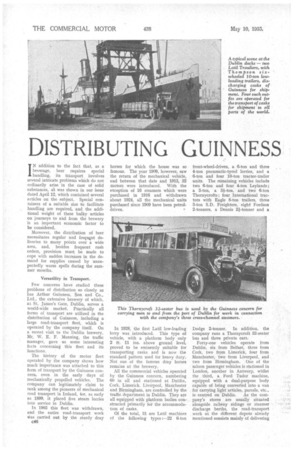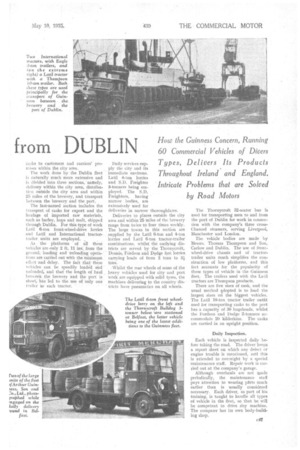DISTRIBUTING GUINNESS
Page 104

Page 105

If you've noticed an error in this article please click here to report it so we can fix it.
from DUBLIN IN addition to the fact that, as a beverage, beer requires special handling, its transport involves several intricate problems which do not ordinarily arise in the case of solid substances, a's was shown in our issue dated April 12, which contained several articles on the subject. Special containers of a suitable size to facilitate handling are required, and the additional weight of these bulky articles on journeys to and from the brewery is an important economic factor to be considered.
Moreover, the distribution of beer necessitates regular and freqiNnt deliveries to many points over a wide area, and, besides frequent rush orders, provision must, be made to cope with sudden increases in the demand for supplies caused by unexpectedly warm spells during the summer months.
Versatility in Transport.
Few concerns have studied these problems of distribution so closely as has Arthur Guinness, Son and Co., Ltd., the extensive brewery of which, at St. James's Gate, Dublin, serves a world-wide market. Practically all forms of transport are utilized in the distribution of Guinness, including a large road-transport fleet, which is operated by the company itself. On a recent visit to the Dublin brewery, Mr. W. E. F. Manning, the traffic manager, gave us some interesting facts concerning this fleet and its functions,
The history of the motor fleet operated by the company shows how much importance was attached to this form of transport by the Guinness concern, even in the early days of mechanically propelled vehicles, The company can legitimately claim to rank among the pioneers of mechanical road transport in Ireland, tor, as early as 1899, it placed five steam lorries into service in Dublin.
In 1903 this fleet was withdrawn, and the entire road-transport work Was carried out by the sturdy dray c46 horses for which the house was so famous. The year 1909, however, saw the return of the mechanical vehicle, and between that date and 1913, 22 motors were introduced. With the exception of 16 steamers which were purchased in 1916 and withdrawn about 1924, all the mechanical units purchased since 1909 have been petroldriven.
In 1928, the first Latil low-loading lorry was introduced. This type of vehicle, with a platform body only 2 ft, 11 ins, above ground level, proved to be eminently suitable for transporting casks and is now the standard pattern used for heavy duty. Not one of the famous dray horses remains at the brewery.
All the commercial vehicles operated by the Guinness concern, numbering 60 in all and stationed at Dublin, Cork, Limerick, Liverpool, Manchester and Birmingham, are controlled by the traffic department in Dublin. They are aU equipped with platform bodies constructed primarily for the accommodation of casks.
Of the total, 31 are Latil machines of the following types :-22 6-ton
front-wheel-driven, a 6-ton and three 4-ton pneumatic-tyred lorries, and a 6-ton and four 10-ton tractor-trailer units. The remaining vehicles include two 6-ton and four 4-ton Leylands; a 3-ton, a 3i-ton, and two 6-ton Thornycrofts ; four International tractors with Eagle 8-ton trailers, three 3-ton S.D. Freighters, eight Fordsou 2-tonners, a Dennis 2i-tonner and a
Dodge 2-tonner. In addition, the company runs a Thornycroft 32-seater bus and three private cars.
Forty-one vehicles operate from Dublin, six from Belfast, three from Cork, two from Limerick, four from Manchester, two from Liverpool, and two from Birmingham. One of the saloon passenger vehicles is stationed in London, another in Antwerp, whilst the third, a Ford Tudor machine, equipped with a dual-purpose body capable of being converted into a van for carrying light articles, parcels, etc.,
is centred on Dublin. As the company's stores are usually situated alongside railway sidings or steamer discharge berths, the road-transport work at the different depots already mentioned consists mainly of delivering
casks to customers and carriers' premises within the city area.
The work done by the Dublin fleet 13 naturally much more extensive and is divided into three sections, namely, delivery within the city area, distribution outside the city area and within 25 miles of the brewery, and transport between the brewery and theport.
The last-named section includes the transport of casks for export and the haulage of imported raw materials, such as barley, hops and malt, shipped through Dublin. For this type of Work Lath 6-ton front-wheel-drive lorries and Lath], and International tractortrailer units'are employed. „
As the platforms of all these vehieleS are only 2 ft 11 ins: from the grotincl,: loading and unloading, operations are carried out with the ininimuni effort and delay. The fact thatthese vehicles can be speedily loaded and unloaded, and that the length of haul Let weell the brewery and the port is short, has led to" the use of 'only one trailer to each tractor.
Daily services supply the city and its immediate environs. LatiI 6-ton lorries and S.D. Freighter 3-tonners being employed. The S.D. Freighters, having narrow bodies, are extensively used for deliveries in narrow thoroughfares.
Deliveries to places outside the city area and within 25 miles of the brewery range from twice to four times weekly. The large towns in this section are supplied by the Latil 6-ton and 4-ton lorries and Latil 6-ton tractor-trailer combinations, whilst' the outlying districts are served by the Thornycroft, Dennis„.F6rdson and Dodge fast lorries, carrying loads of from 2 'tons to 31 tons.
.Whilst the rear wheels of some of the heavy vehicles used for city and port Work are equipped with solid tyres, the machines delivering to the country districts have pneumatics on all wheels. The Thornycroft 32-seater bus is used for transporting men to and from the port of Dublin for work in connection with the company's three crossChannel steamers, serving Liverpool, Manchester and London.
The vehicle bodies are made by Messrs. Thomas Thompson and Son, Carlow and Dublin. The use of frontwheel-drive chassis and of tractortrailer units much simplifies the construction of low platforms, and this fact accounts for the popularity of these types of vehicle in the Guinness fleet. The trailers used with the Latil tractors are Thompson products.
There are five sizes of cask, and the usual method adopted is to load the largest sizes on the biggest vehicles. The Latil 10-ton tractor trailer outfit used for transporting casks to the port has a capacity of 30 hogsheads, whilst the Fordson and Dodge 2,tonners accommodate 20 kilderkins. The casks are carried in an upright position.
Daily Inspection.
Each vehicle is inspected daily before taking the road. The driver keeps a report sheet on which any defect or engine trouble is mentioned, arrd this is attended to overnight by a special maintenance staff. Repair work is carlied out at the company's garage.
Although overhauls are not made periodically, the maintenance staff pays attention to wearing parts much earlier than is usually considered necessary. Each driver, as part of his training, is taught to handle all types of vehicle in the fleet, so that he will be competent to drive any machine. The company has its own body-building shop.




































































































































































